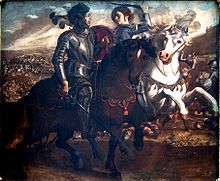Jerusalem Delivered
The work belongs to the Italian Renaissance tradition of the romantic epic poem, and Tasso frequently borrows plot elements and character types directly from Ariosto's Orlando Furioso.To prevent the crusaders from cutting timber for siege engines, the Muslim sorcerer Ismen protects the forest with enchantments, which defeat the Christian knights, even Tancredi (Canto 13).He has the same name as a Carolingian paladin count who is a character in Ariosto's Orlando Furioso [III, 30]; he is the son of Bertoldo and was the reputed founder of the House of Este.By giving Rinaldo a mirror of diamond, they force him to see himself in his effeminate and amorous state and to return to the war, leaving Armida heartbroken (Cantos 14–16).The poem was immensely successful throughout Europe and over the next two centuries various sections were frequently adapted as individual storylines for madrigals, operas, plays, ballets and masquerades.[3] Most depictions until the 19th century use vaguely classical costume (at least for the men) and settings; by then Lord Byron, Sir Walter Scott and other romantic writers had begun to replace Tasso as sources of exotic love stories to adapt into other media.A set of ten large canvases by Paolo Domenico Finoglia were painted from 1634 on for the Palazzo Acquaviva in Conversano in Apulia, home of the local ruler, where they remain.[6] The series of ten large paintings by Finoglio has the following scenes, which may be taken as typical: The fame of Tasso's poem quickly spread throughout the European continent.In England, Sidney, Daniel and Drayton seem to have admired it, and, most importantly, Edmund Spenser described Tasso as an "excellente poete" and made use of elements from Gerusalemme liberata in The Faerie Queene.In the twelfth canto of Book Two, Spenser's enchantress Acrasia is partly modelled on Tasso's Armida, and the English poet directly imitated two stanzas from the Italian.The first attempt to translate Gerusalemme liberata into English was made by Richard Carew, who published his version of the first five cantos as Godfrey of Bulloigne or the recoverie of Hierusalem in 1594.The English critic George Saintsbury (1845–1933) recorded that "Every girl from Scott's heroines to my own sisters seem to have been taught Dante and Petrarch and Tasso and even Ariosto, as a matter of course.














ArmidaNicolas PoussinItalianepic poemItalian poetTorquato TassoFirst CrusadeGodfrey of Bouillontake JerusalemDuke Alfonso of FerraraFerraraOttoman EmpireFrench RevolutionRomantic movementFrançois Boucherstanzasottava rimacantosItalian RenaissanceAriostoOrlando FuriosoVirgilErminia (disambiguation)Paolo Domenico FinogliaConstantinopleAlexios I KomnenosSultanate of Rumtaking Jerusalem in 1099Tancred, Prince of GalileeClorindaCamillaBradamanteHeliodorus of Emesaforest with enchantmentsGuercinoAntiochAscalonGiovanni Battista TiepoloAlcinaHouse of EsteEugène DelacroixRuggieroCalypsoOdysseusOgygiaMorgan le FayOgier the DaneTemple MountAlessandro TurchiBaroqueLord ByronWalter ScottarmourpastoralfrescotapestryConversanoApuliaPalace of FontainebleauSchool of FontainebleauVilla Valmarana (Lisiera)VenetoLudwig II of BavariaSchloss HohenschwangauCornaro familyArt Institute of ChicagoFlorenceetchingsAntonio TempestaGiacinto GimignaniSidneyDanielDraytonEdmund SpenserThe Faerie QueeneParadise LostRichard CarewEdward FairfaxJohn HooleAnthony EsolenMax WickertGeorge SaintsburyDomenico TintorettoFrancesco MaffeiAnthony van DyckGiaches de WertCombattimento di Tancredi e ClorindaClaudio MonteverdiBiagio MariniGirolamo GiacobbiMichelangelo RossiBenedetto FerrariMarco MarazzoliArmideJean-Baptiste LullyCarlo PallavicinoCarlo Francesco PollaroloTancrèdeAndré CampraPhilippe II duke of OrleansArmida abbandonataGiovanni Maria RuggieriRinaldoGeorge Frideric HandelGiacomo RampiniGiuseppe Maria BuiniAntonio VivaldiHenry DesmarestGeorg Caspar SchurmannAntonio BioniTomaso AlbinoniAntonio PollaroloFerdinando BertoniLuca Antonio PredieriCarl Heinrich GraunFrancesco GeminianiTommaso TraettaNiccolò JommelliAntonio SalieriChristoph Willibald GluckJosef MyslivečekRenaudAntonio SacchiniJoseph HaydnGiuseppe SartiTancredi